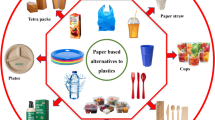Abstract
The potential of soy protein-based plywood glues for foam extrusion was evaluated. Standard glue mixes containing the soy flours Honeysoy 90, ISU-CCUR, Nutrisoy 7B, and defatted Soyafluff, and the soy concentrates Arcon F and Procon 2000 showed excellent foaming and adhesive qualities but did not have the ability to refoam. To improve refoaming capability, the formulations were modified by increasing the quantities of soy flour or concentrate so that they provided 3.48 g protein/100 g of glue mix. This was the amount of protein contributed by animal blood when it was used as the extender in the standard formulation for foamed glue. All the modified glues containing soy flour or concentrate had good refoaming properties and adhesive strengths that were at least equal to that of the control glue. Simple cost analysis also indicated that when soy flour was used, the modified formulations were cheaper to produce than the current blood-based glue.
Similar content being viewed by others
References
Hettiarachchy, N.S., U. Kalapathy, and D.J. Myers, Alkali-Modified Soy Protein with Improved Adhesive and Hydrophobic Properties, J. Am. Oil. Chem. Soc. 72:1461–1464 (1995).
Kalapathy, U., N.S. Hettiarachchy, D.J. Myers, and M.A. Hanna, Modification of Soy Proteins and Their Adhesive Properties on Woods, ——Ibid. 72:507–510 (1995).
Myers, D.J., M.L. Kuo, D.D. Stokke, and Y. Bian, Continued Research and Development of the Soy Protein-Phenol Formaldehyde Adhesive for the Manufacture of Fiberboard Products, inform 11 (Special Supplement, Abstracts of the 91st AOCS Annual Meeting and Expo):S69 (2000).
Sun, X., and K. Bian, Shear Strength and Water Resistance of Modified Soy Protein Adhesives, J. Am. Oil. Chem. Soc. 76: 977–980 (1999).
Thames, S.F., L. Zhou, and R.C. Cook, Soybean Protein Adhesives for the Production of Formaldehyde-Free Wood Composites, inform 9 (Special Supplement, Abstracts of the 89th AOCS Annual Meeting and Expo):17 (1998).
Sellers, T., Jr., Adhesive Application (Foam Extrusion), in Plywood and Adhesive Technology, Marcel Dekker, New York, 1985, pp. 208–218.
Kinsella, J.E., Functional Properties of Soy Proteins, J. Am. Oil. Chem. Soc. 56:242–258 (1979).
Hojilla-Evangelista, M.P., and L.B. Dunn, Jr. Foaming Properties of Soybean Protein-Based Plywood Adhesives, ——Ibid. 78:567–572 (2001).
Anonymous, Growth Continues in Chemical Production, Chem. Eng. News 72 (July 4, issue 27):34 (1994).
Sellers, T., Jr., Glue Line Quality in Plywood, in Plywood and Adhesive Technology, Marcel Dekker, New York, 1985, p. 532.
American Plywood Association, Adhesive Policy, APA, Tacoma, WA, 1984, pp. 7–8.
U.S. Dept. of Commerce, Voluntary Product Standard PSI-83 for Construction and Industrial Plywood, United States Government Printing Office, Washington, DC, 1983.
Author information
Authors and Affiliations
Corresponding author
About this article
Cite this article
Hojilla-Evangelista, M.P. Adhesive qualities of soybean protein-based foamed plywood glues. J Amer Oil Chem Soc 79, 1145–1149 (2002). https://doi.org/10.1007/s11746-002-0618-z
Received:
Accepted:
Issue Date:
DOI: https://doi.org/10.1007/s11746-002-0618-z




